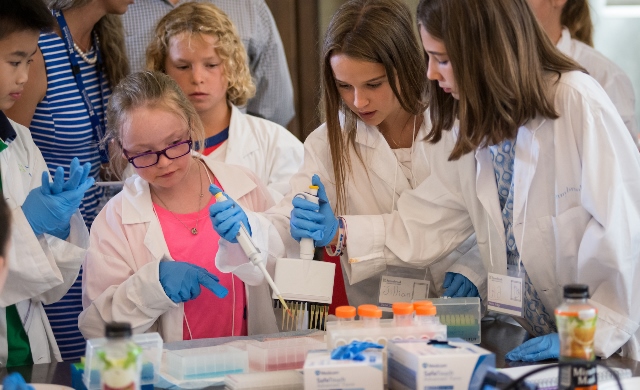
By Alexis Dobranowski
An enthusiastic group of elementary school students took time out of their summer holidays to visit Sunnybrook for a day of learning – and teaching – for the annual Tell it to a Fifth Grader Research Contest.
As part of the D+H Sunnybrook Research Institute Summer Student Research Day, university summer students were invited to submit a simple summary of their work in a way the public – even kids – would understand. More than 45 projects were submitted.
Eleven youngsters took part in judging the finalists, who presented complicated research about Alzheimer’s Disease, risk assessment for ACL injury, and cochlear implant technology using plain language and kid-approved analogies.
“A person becomes deaf when the ear stops working because of little nerve cells dying, like how a TV would stop working if I cut its power wire or if the wire got frayed or broken,” said Dilakshan Srikanthan, a student at University of Toronto, to start off his presentation about a camera that helps surgeons take pictures inside the ear in preparation for cochlear implant surgery.

The young students didn’t let the summer researchers off easy. Hands shot up when words needed clarification or something didn’t quite make sense to the 5th graders. The event aims to help teach the undergraduate scientists how to breakdown their research in ways the public can understand.
Katie Bozek, a fourth-year undergraduate student from the University of Toronto, took home the first-place ribbon (and a cash prize) for her presentation about exploring how swine flu bugs stay in pig barns and can spread.
“The contest was an excellent idea to showcase real scientific research to young students. It also provided an opportunity for up-and-coming scientists like myself to highlight the importance of making science accessible for everyone,” she said.
In addition to the presentations, the young students also visited two cell-sorting labs and tried their own hands at pipetting.
“I give the day a 10 out of 10,” said Charlotte Jez, age 10. “Every fifth grader should get to meet a scientist or researcher.”
The initiative is part of Sunnybrook’s ongoing effort to involve the community in all aspects of the health-care setting and bring research to the public.
“At Sunnybrook, we like to find new ways to engage the community and show them how research relates to everyday life, so it’s important that our researchers can explain their amazing, complex work to the public,” said Craig DuHamel, VP Communications. “We have about 150 summer students at Sunnybrook each year doing really incredible research, publishing papers and presenting at international conferences. We thought it’d be great to ask these students to practice sharing that work in a way the general public can understand.”
Congratulations to Katie and the other finalists: Dilakshan Srikanthan, Emma Griese, Michael Rosen, Lee Yu (Tina) Wu, Megan Lam. And a big thank you to the 5th graders (and their siblings): Abby, Bosco, Charlotte, Hayden, Jillian, Jordyn, Lila, Mary, Nyla, Sacha and Taya.
For information about Sunnybrook’s undergraduate summer student program, visit sunnybrook.ca/research
Alexis Dobranowski works in communications at Sunnybrook Health Sciences Centre.

